By
Cliff Carlisle
Between 1900 and
the start of WW2 most countries adopted a semi auto pistol for their military.
This article will attempt to list most of those pistols that were in use
prior to 1960.
Argentina.
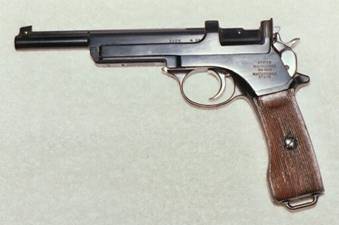
In 1905 the Argentine
military adopted the M1901 Mannlicher pistol as their M1905. This
was a charger loaded pistol chambered for the 7.65X21 Mannlicher round
that did not have a removable magazine. They were loaded from the
top with a charger of cartridges like a Mauser rifle. Most of these
pistols encountered in the US have had the Argentine crest removed from
the right side & have been re-blued.
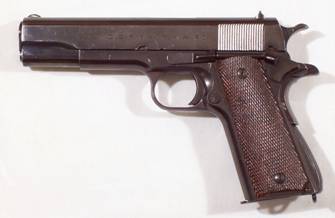
Argentine M1927
pistol.
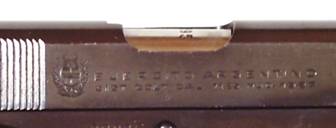
Argentine crest
on slide of M1927.
In 1916 the Colt
M1911 was adopted as the M1916. After the Colt had been updated to
the M1911A1 Argentina adopted it as their M1927. The M1927 was both
purchased from Colt and produced by Argentina.
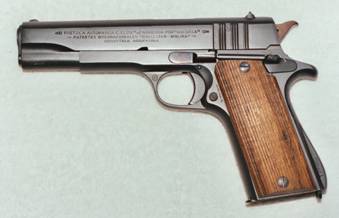
The M1927 was simplified
for production in the 1930s and produced as the Ballester Molina.
The major changes were the removal of the grip safety & the use of
a pivoting trigger instead of the Colt sliding one. These are found
with the slide stamped to indicate issuance to the Argentine Army, Navy
and Air Force.
Austria.
See Austro-Hungarian
Pistols.
Belgium.
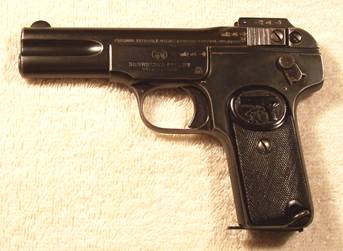
In 1900 Belgium
became one of the first countries to adopt a semi auto military pistol.
This was the M1900, the first Browning designed pistol produced by Fabrique
National. It was a blowback pistol chambered for the 7.65X17 (.32
ACP) cartridge.

Photo courtesy www.collectorfirearms.us.
FN did not resume
production of the M1900 after WW1. Consequently, the Browning designed
M1910 was adopted by the Belgium military in 1919. Both the M1900
& M1910 remained in Belgium service until the adoption of the M1935.
In the early1920s
John Browning had designed a locked breech pistol (based on his Colt M1911
design) for the French semi auto pistol trials. It was submitted
by John Browning’s son Val in 1922. France did not adopt this pistol
but after Browning’s death the Belgium designer Dieudonne Suiave at FN
further improved the design. The resulting pistol was adopted by
the Belgium government as the M1935. It was issued with a flat board
shoulder stock so it could be used as a pistol-carbine. This pistol
is popularly known in the US as the Browning High Power.
British Commonwealth.
The British Commonwealth
was the last major country to adopt a semi auto pistol for their Army.
They used revolvers through the second world war. Their Navy did
adopt a semi auto in 1913 as the Mk 1 Navy.
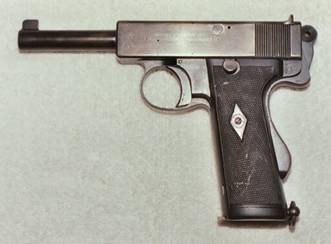
The Mk 1 N was a
locked breech pistol chambered for the .455 Webley Automatic (11.43X23.5Sr)
cartridge. There was very limited Army use of the .455 Webley by
the Royal Household Cavalry. These cavalry used pistols were equipped
with a flat board shoulder stock. During WW1 the British bought Colt
M1911 pistols chambered for this .455 automatic cartridge which was not
interchangeable with the .45 ACP.
After the fall of
Belgium in WW2 the John Inglis Company in Canada started production of
the Belgium Browning M1935 for the Chinese Government (see China below
for a photo). These pistols, like the original FN produced ones,
had adjustable rear sights & were cut for a shoulder stock. Unlike
the FN shoulder stocks these were like the Mauser M1896 (Broomhandle) in
that they were a combination shoulder stock & holster.

Photo courtesy of
www.collectorfirearms.us
After the Chinese
order was filled the pistol was modified by the replacement of the adjustable
sight with a fixed one & the removal of the shoulder stock slot.
This version was adopted by Canada as the Mk 1*.
China.
China had been exploited
by the major world powers up until after WW1. There was constant
war between the various factions in the country after the fall of the Imperial
Government. The Washington Arms Conference of 1921 – 1922 implemented
an arms embargo on China. No rifles could be exported to her by any
member country of the Conference. Since pistols were not embargoed,
the various factions in China started buying Mauser M1896 (Broomhandle)
pistols with shoulder stock holsters. Mauser couldn’t produce
them fast enough so they started buying Astra & Royal made copies from
Spain and producing copies themselves.
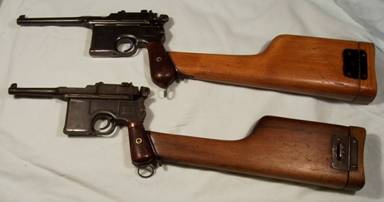
Mauser M1896 Broomhandle
& Bolo (short barrel & smaller grip) with shoulder stock holsters.
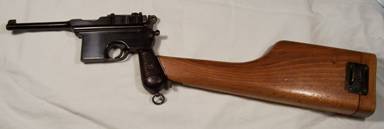
Astra 900 with shoulder
stock holster.
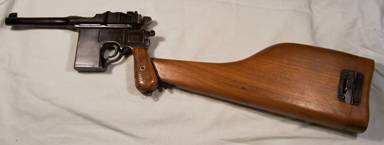
Chinese made .45
ACP copy of Mauser M1896.
During WW2 China
contracted with Inglis in Canada to produce the M1935 Browning High Power
for them. Like the Broomhandle, they ordered it complete with a shoulder
stock holster.

Canadian Inglis
with shoulder stock holster.
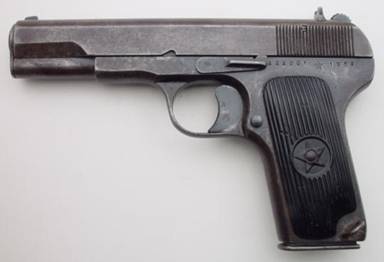
Photo courtesy www.collectorfirearms.us.
In 1951 China adopted
the Russian Tokarev TT33 as the Type 51 pistol.
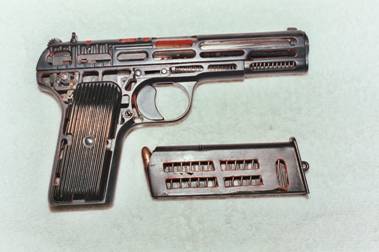
1950 dated Chinese
cut away Tokarev used for instructional purposes.
In 1954 the Type
51 was modified slightly & the new design adopted as the Type 54.
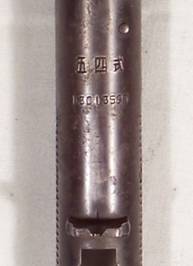
Slide markings on
a Type 54 pistol. These markings read from left to right. The
Chinese characters are the number 5, 4 & the word Type.
Czechoslovakia.
See Pistols
under Czech Arms 1919 – 1958.
Denmark.
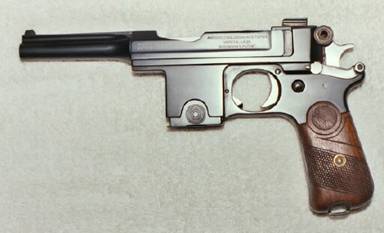
The Belgium firm
of Bayard had developed a locked breech pistol chambered for the 9X23 cartridge
called the M1908 Bergman Bayard. In 1911 the Danish Army adopted
the Bergman Bayard as the M1910. The M1910 was produced for Denmark
by the firm of Pieper in Belgium. 4840 were procured. In 1922
minor changes were made to the M1910 & the modified pistol adopted
as the M1910/21. The M1910/21 was produced by Danish Army Arsenal.
Only 2204 were made. Between 1922 & 1935 all of the M1910 pistols
on hand were converted to the M1910/21 configuration.
In 1940 Denmark
adopted the FN Browning M1935 Hi Power but the German invasion prevented
their issue. In 1946 the order was again placed with FN and the Hi
Power was designated the M46. 1577 pistols were procured.
Egypt.
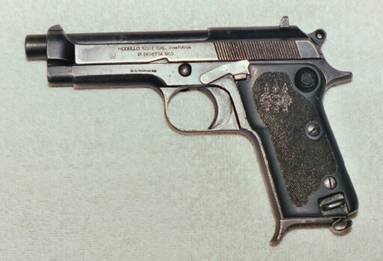
Egypt used revolvers
until the purchase of Beretta M951 pistols in the early 1950s. These
Egyptian contract pistols have a shorter slide than the standard M951 leaving
more of the barrel exposed than on the standard models. In addition,
the Egyptians had the push button magazine release replaced with a bottom
release.
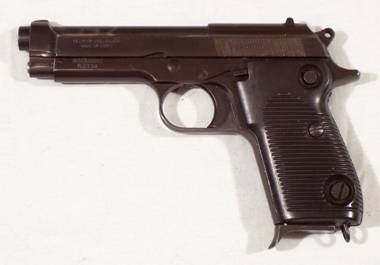
After the Beretta
purchase, Egypt produced a copy of the Beretta M951 as the Helwan.
Finland.
Finland purchased
& used a wide variety of pistols prior to WW2. The Luger in 7.65mm
was adopted in 1923. In 1935 the Finnish designed Lahti was adopted
as the L-35. Sweden adopted the Lahti as the M40 & this pistol
is illustrated under Sweden.
France.
See French
Semi Auto Pistols.
Germany.
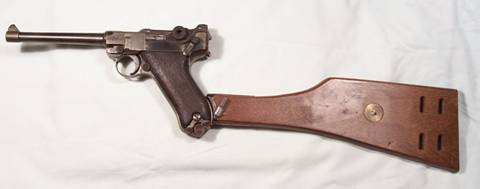
In 1904 the Navy
adopted the first semi auto pistol to be used by the German military.
This was the famed German Luger in 9X19 caliber. The navy models
had 6” barrels with an adjustable sight on the rear of the toggle and were
issued with a flat board shoulder stock. The first version was the
P04 (Pistole M1904) which was modified in 1906, 1908 & 1914 as changes
were made to the basic design. The most visible difference is that
the 1904 & 1906 variation had a grip safety while the 1908 & 1914
did not. Approximately 62,000 Naval Lugers of all variations were
procured by the Navy.
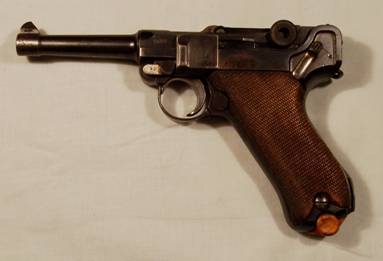
In 1908 the Army
followed suite by adopting the Luger as the Pistol 08. These had
a 4” barrel and even though the grip frame had the stock slot, the stock
was not issued with this version. This was the most common pistol
used by the Germans in WW1. It was produced by both DWM (Deutsche
Waffen u. Munitionsfabriken) and the German Army Erfurt arsenal.
DWM produced approximately 665,000 & Erfurt produced about 492,000
for a total of 1,157,000 procured by the German military by the end of
WW1.
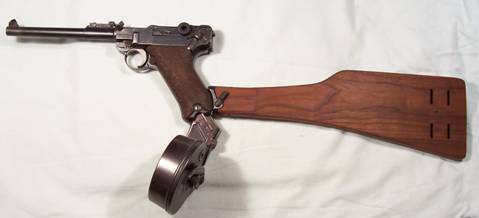
In 1913 the German
army adopted a P08 with an 8” barrel and a 9 position adjustable rear sight
mounted on the barrel as the Lange P08 or Long Pistol, Model 1908.
Production started in 1914 at both DWM & Erfurt. DWM produced
the LP08 until 1918 but Erfurt ceased production in late 1914. Approximately
205,000 were procured by the military. In 1917 a 32 round Trommel
Magazine (snail drum) was adopted for the LP08. With the shoulder
stock & drum magazine this made a very effective trench warfare weapon.
The LP08 pistol has long been called the Artillery Luger by US collectors.
With WW1 increasing
the need for more pistols the military looked to the commercial market
for additional weapons. The following is a list of German produced
pistols that were purchased by the military. All of the officially
purchased pistols have German Military acceptance stamps on them.
The Crown over N & U are commercial proofs that are found on these
guns. To be military procured they also should have a Crown over
a Gothic letter in addition to the Crown N or Crown U. The letters
differ according to who inspected them. German officers could &
some did buy their own pistols but these were not officially procured and
are not technically German military issue pistols.
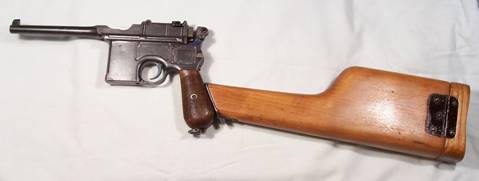
The Mauser M1896
(Broomhandle) pistol was in production so the military bought roughly 50,000
of them complete with shoulder stock holsters. However, this pistol
was chambered for the 7.63X25 cartridge which was not a round used by the
German military.
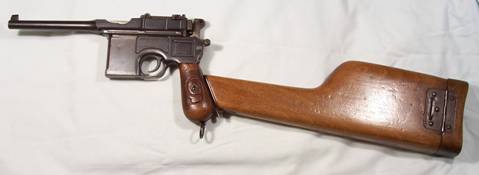
In 1916 the Army
contracted with Mauser to produce the Broomhandle in 9X19, the standard
German military caliber. This pistol was designated as the
M1896/16 and about 140,000 were delivered to the army before the end of
the war. The grips are marked with a red 9 to indicate the proper
round for them. They are called the Red 9 Mauser or Red 9 Broomhandle
by collectors.
The following pistols
are all in 7.65X17 (.32 acp), the secondary caliber used by the German
military.

The Walther firm
had been in production of their M4 pistol since 1910. The German
government procured over 75,000 of this model for military use.
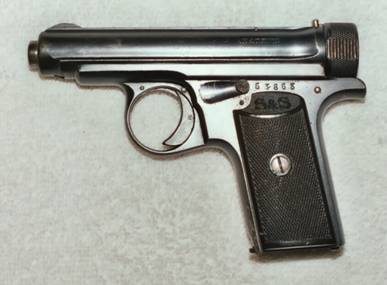
The firm of J. P.
Sauer & Son had started production of their M1913 pistol in 1913.
The German military officially procured less than 10,000 of these.
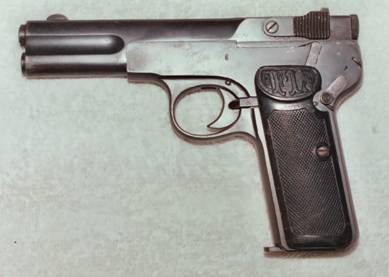
The firm of Langenhan
Gewehre und Fahrradfabrik produced the FL Selbstlader (self loader) from
1915 to 1918. The military procured most of the production of 85,000
pistols.

Rheinmetall had
been producing their M1907 since 1907. The military had procured
about 80,000 by 1918.

In addition to the
above mentioned Broomhandle, Mauser was also in production of the M1914
when WW1 started. By 1918 the military had procured over 100,000
of these pistols.
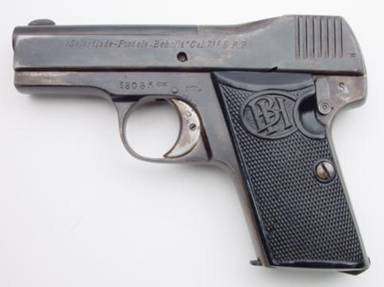
Photo courtesy www.collectorfirearms.us.
Becker & Hollander
in Shul, Germany, started production of their Beholla pistol in 1915.
About 45,000 were produced & most were procured by the military.
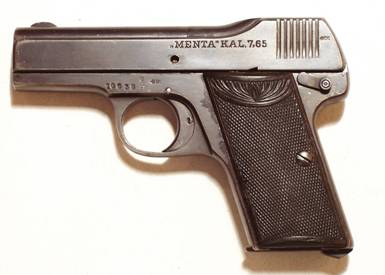
Basically the same
pistol was produced by August Menz in Shul. Less than 1000 of this
firms version were procured.
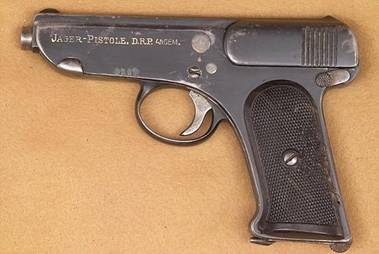
The Jager &
Company in Suhl started production of a stamped sheet metal pistol in 1914.
The Jager pistol is the first known use of this construction in a handgun.
The military procured a few thousand of these. The exact quantity
is not known.
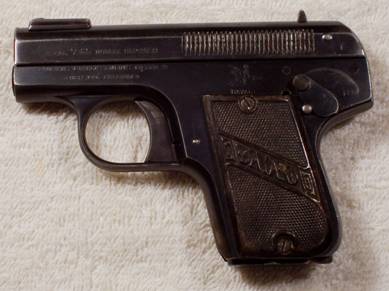
After Germany had
captured Belgium the firm of Anc. Establissements Pieper in Herstal, Belgium,
was kept in production of their M1908 Bayard pistol. This is probably
the smallest handgun ever issued in quantity to a military force.
About 100,000 were procured.
In addition to purchasing
German produced pistols & continuing production in occupied countries,
the military placed orders with at least 2 of her allies.

In 1916 Bavaria
placed an order with Steyr in Austria for 10,000 M1912 Steyr Hahn pistols
in 9X23. These were given their own serial numbers starting with
number 1. They have no German acceptance marks. They can only
be told from Austrian used pistols by the serial number having no letter
after the number, having the date 1916 stamped on the left slide and having
the Austrian Wn16 stamp on the right trigger guard. A follow up order
was placed in 1918 for an additional 6,000 pistols. Again, they had
no special markings but continued the S/N from the original order.
The trigger guard is marked Wn18 on this order.
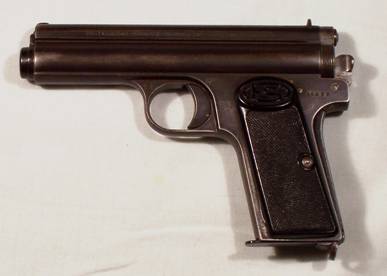
An order was also
placed with Fegyvergyar in Budapest, Hungary, for the M1912 Frommer Stop.
The first production received both the Crown B and a smaller Crown D acceptance
stamp on the trigger guard. The rest of the order had just the Crown
D stamp.
As Germany was preparing
for WW2 they again had a need for many more pistols than they had in inventory.
The need continued to exceed production throughout the war. At it’s
peak strength, the German military numbered over 10,500,000 men.
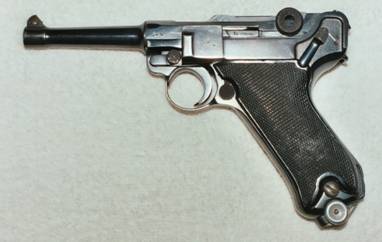
Mauser had ended
up with the manufacturing machinery to produce the P08 Luger. Military
procurement started in 1934. By this time the German military was
using codes for manufacturers to conceal who was producing what for them.
Mauser used the codes S/42, 42 & byf on the center toggle. In
addition, they used a date code for the first 2 years of production.
1934 had a K stamped over the chamber while 1935 had a G. From 1936
until 1942 when Mauser ended production over 929,000 P08 pistols were procured
by the army. The P08 was also produced for the Luftwaffe (air force)
by Krieghoff Waffenfabrik from 1935 to 1945. Only slightly more than
12,000 Krieghoff P08 pistols were produced.
Because the P08
was a very complicated & costly pistol to produce, the military searched
for a simpler, more easily produced 9X19 pistol.
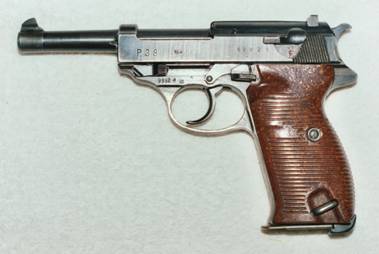
The Walther firm
had developed an excellent double action pistol that was adopted in 1938
as the P38. This was the first of the “modern” double action pistols
adopted by the military of a major nation. In addition to Walther both
Mauser & Spreewerke produced the P38. Walther supplied 594,100,
Mauser 346,800 & Spreewerke 284,500 for a total of 1,224,600 pistols.
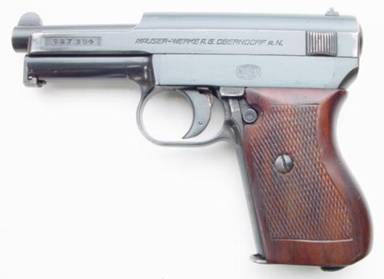
Photo courtesy www.collectorfirearms.us.
The Mauser M1934
was an improved version of the WW1 M1914. The German military procured
about 8000 of these pistols from 1940 to 1941.

The manufacture
of the M1934 Mauser was discontinued in 1941 after the introduction of
the double action Model HSc in 1940. The streamlined HSc was procured
by the military from 1940 through 1945. A total of about 75,000 were
procured.
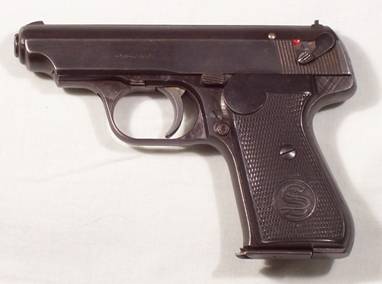
The firm of J.P.
Sauer had started production of their Model 38H in 1939. This was
an innovative design as it had a cocking & de-cocking lever on the
left side of the frame. The military procured about 50,000 between
1940 & 1945.
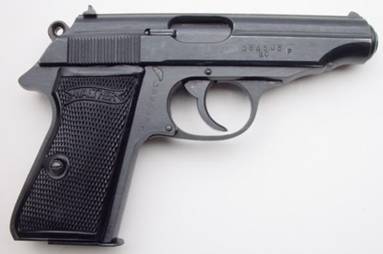
Photo courtesy www.collectorfirearms.us.
In 1929 Walther
had introduced their excellent Model PP (Police Pistol) double action pistol.
This was the first commercially successful double action semi auto.
The military procured about 84,000 between 1940 and 1945.
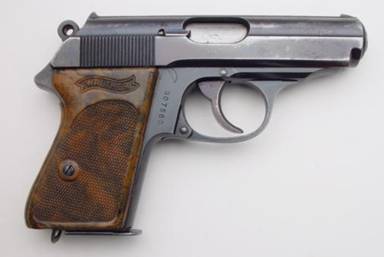
Photo courtesy www.collectorfirearms.us.
In 1930 Walther
introduced a shorter version of the PP as the PPK (police pistol criminal)
for plain clothes police officers. The military procured about 26,000
between 1940 & 1945.
Even with procuring
pistols from German commercial arms producers, the military could not meet
the demand from the field for hand guns. The military re-issued almost
all of the military pistols that were captured during the war and were
still short of their needs. Consequently, arms producers in occupied
countries were kept in production to supply weapons to the German military.
The Fabrique National
plant in Belgium had been producing both the Browning M1935 High Power
& the M1922 prior to the outbreak of war for various countries military
forces.
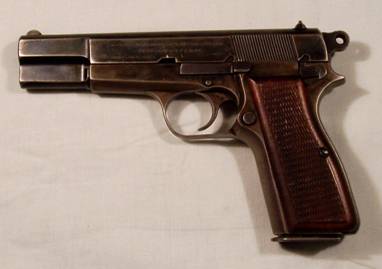
The M1935 Grande
Puissance (High Power) had a 13 round magazine and had been adopted by
the Belgium military in 1935. German troops occupied the FN plant
on May 29, 1940. Pistols found in the factory by the Germans were
issued without acceptance stamps. Production was re-started and by
September, 1944, when the FN plant was liberated by the allies, the German
military had accepted over 319,000 M1935 HP pistols.
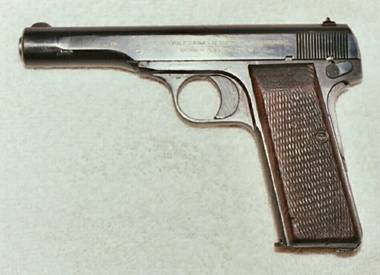
The FN M1922 pistol
was a modified M1910 Browning. The barrel was lengthened and an extension
put on the end of the slide to bring it to the same length. In addition
the grip was extended to accommodate a longer magazine holding 9 rounds
of .32 acp instead of the 7 used in the M1910. After the German invasion
around 3200 sets of parts were found in the FN plant that were in .380
acp. These were finished by the Germans & issued with acceptance
stamps. The parts for the .32 acp version were used up and new production
undertaken. By September, 1944, about 363,000 M1922 pistols were
accepted by the German military.
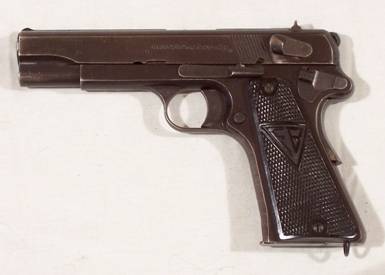
On September 1st,
1939, Germany invaded Poland. The Polish army was armed with the
M1935 Radom pistol. This was an excellent Browning design & the
German military kept it in production until January of 1945 when production
was moved to Steyr in Austria due to the Russian advance into Poland.
Steyr produced about 22,000 of the Radom pistols until the Russians over
ran their plant in April, 1945. A total of about 313,000 were procured
by the German military.
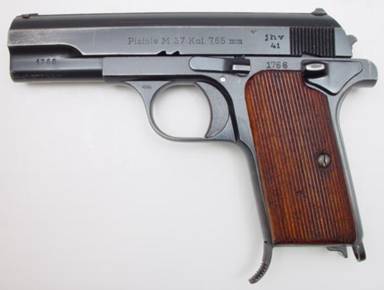
Photo courtesy www.collectorfirearms.us.
Hungary was an ally
of Germany in WW2. The Hungarian military was using the Model 37M
Femaru pistol in .380 acp. The German Luftwaffe (Air Force) had it
slightly modified with the addition of a safety lever and chambered for
the .32 acp. They placed an order for 50,000 of these in 1941.
By the end of the war about 80,000 had been procured.
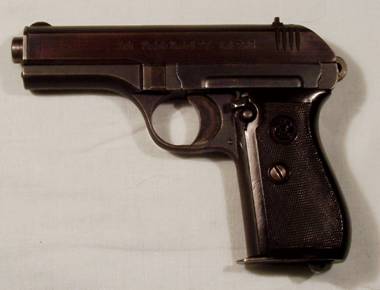
By March, 1939,
Germany had annexed most of Czechoslovakia. The CZ27 pistol, although
never adopted by the Czech military, had been in commercial production
since 1927. The Germans kept the CZ27 in production until the end
of the war. A total of about 455,000 pistols were procured.
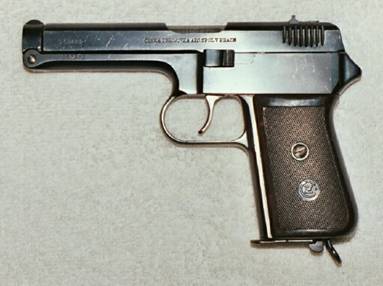
In 1938 the Czech
government placed an order for 41,000 double action only CZ38 pistols in
.380 acp. When Germany occupied Czechoslovakia in March 1939 most
of these pistols were complete but still at the factory. The German
military designated these as the P.39(t) and issued them to the army &
air force. A total of about 45,000 were procured.

France had adopted
the M1935A pistol in 1935. It was in production when Germany invaded
France. Even though it was in the non standard 7.65mm Long French
caliber the German authorities kept it in production. Only about
24,000 were procured.

The French firm
Manufacture D’Armes Des Pyrenees had a Ruby type pistol in production as
the Unique 17. Germany kept it in production & procured about
30,000 of them.
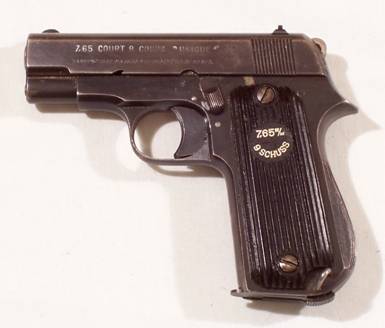
The Unique 17 was
re-designed by the Germans to include an arched back strap & and external
hammer. This was designated the Unique Kriegsmodell with about 18,000
procured.
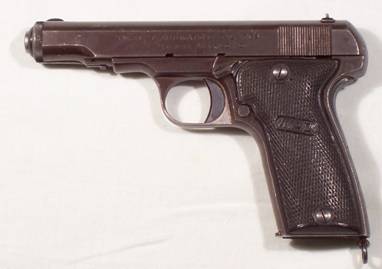
The French firm
Manufacture D’Armes Des Bayonne had produced their MAB Model D for the
French Army prior to the German invasion. It was kept in production
for the Germans with about 50,000 procured.
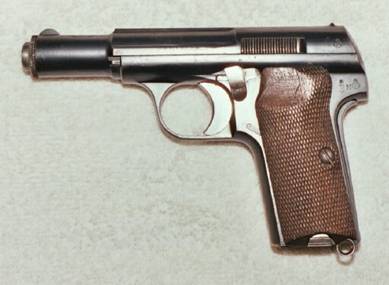
Astra, in Spain,
was producing several models of auto pistols for the commercial market.
The Astra 300 was a small pistol made in both .32 acp & .380 acp.
Between October 1941 & July 1944 Germany bought 63,000 of the .380
pistols & 22,390 of the .32 acp ones. The .380 chambered pistols
have a German acceptance stamp but the .32 acp ones don’t. The Astra
records list the S/Ns shipped to Germany & that is the only way to
identify a German procured .32 acp Astra 300.

Spain had adopted
the Astra 400 as the M1921 for their military. Even though it is
chambered for the non standard 9X23 Largo Germany bought 6,000 Astra 400s
for the army. None have a German acceptance stamp. Astra records
show that they were all in the 92851 to 98850 S/N range.
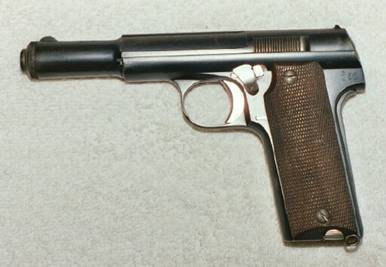
At the request of
the German military, who wanted a smaller pistol than the Astra 400 in
9X19, Astra designed their Model 600 in 1943. Between the 16th of
May & 16th of July, 1944, 10,540 Astra 600 pistols were delivered to
the German military across the Spanish/French border. Another 28,000
had been purchased but the allied advance in France prevented their delivery.
Only the first 10,540 have German acceptance stamps.
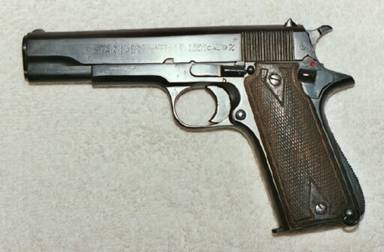
The Spanish firm
of Star Bonifacio Echeverria SA had been making copies of the Colt Browning
pistols since 1921. Germany purchased 25,000 of the Star Model B
pistol during WW2. All have German acceptance stamps.
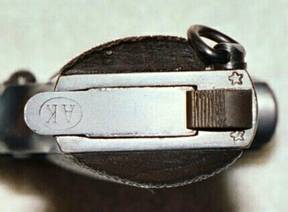
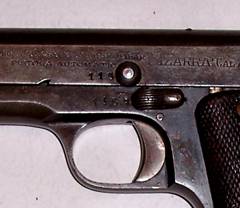
In 1914 Gabilondo y
Urresti had started production of the Ruby pistol. It was a simplified
copy of the Browning 1903 but in 7.65mm. France placed an order with
Gabilondo y Urresti for 30,000 pistols a month to start in August 1915.
They did not have the capacity to produce anything like that quantity,
so they went to other arms producers in Spain. By 1918 when the war
ended, at least 39 separate Spanish arms manufacturers had produced the
Ruby for France. These pistols ranged in quality from excellent to
non-functional. Some even fired full auto when the trigger was pulled.
Interchangeability of parts was almost non existent to the point that the
frame & magazines were stamped with manufacturers initial codes as
most magazines wouldn’t interchange from one manufacturer to another.
There is no record of the number of Ruby pistols purchased from Spain but
the figure including Star pistols is 968,220. After WW1 the French
military went through their stocks of pistols removing the ones of questionable
quality. It’s thought that the acceptable ones were stamped with
2 stars on the butt as an acceptance stamp. Some were also fitted
with a large rivet in the slide just above the safety lever. This
was to prevent the safety from being knocked into the fire position when
it was placed in the holster. Even though it is hard to believe,
the Ruby remained in French service through WW2 & was still issued
to the army during the French conflicts in Algeria & Indo China.
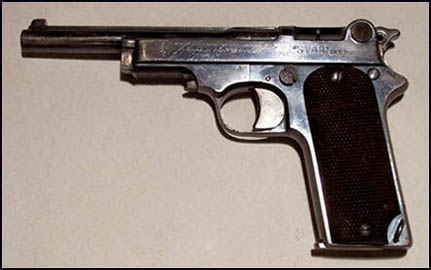
In 1915 France also
placed an order with Echeverria in Spain for their M1914 Star pistol.
It was a much-simplified copy of the M1903 Mannlicher but with a detachable
magazine & in 7.65mm. It was an 8 shot pistol with a 130mm long
barrel. This first production was this smaller pistol and is referred
to as the Officer Model. Later pistols (most of those procured) had
a 9 shot magazine with a 138mm long barrel and were termed the Trooper
Model. The total quantity of Stars received is unknown as Echeverria
also supplied the Ruby to France and didn’t keep separate records as to
which model was shipped. Combined shipments of Star & Ruby pistols
was 23,000 to 25,000.
Hungary.
See Austro-Hungarian
Pistols.
Italy.
See Italian
Semi Auto Pistols.
Japan.
See Japanese
Pistols
Mexico.
Mexico adopted
the Colt M1911 .45 acp pistol right after WW1. After the M1911 had
improvements made to it in 1926 resulting in the M1911A1, Mexico was the
first to receive any of these pistols.

A native designed
.45 acp pistol was produced from 1936 to 1938. This was the Obregon.
The basic design was like the Colt but instead of a dropping barrel locking
system it used a modification of the Steyr Hahn rotating barrel system.
The front half of the slide is round in cross section to accommodate the
rotating barrel. Another interesting feature was the combination slide
stop & safety. One long lever was used to perform both of these
functions. Due to the cost of production of this more complicated
design it did not remain in production for long with only 800 to 1000 pistols
being produced.
Netherlands.
The Netherlands
Indies Army adopted the Luger as the M1911 & procured 4181 pistols
from DWM in Germany.
In 1919 the Indies
Army
needed additional Lugers but Germany was prevented from making pistols
by the Versailles Treaty. Consequently a deal was made between the
British firm Vickers Ltd. & the German firm DWM for the production
of the order. DWM made all of the parts & they were shipped to
Vickers in the white. Vickers finished making the pistols & marked
them with their Vickers Ltd. Logo. 6000 were procured by the Indies
Army.
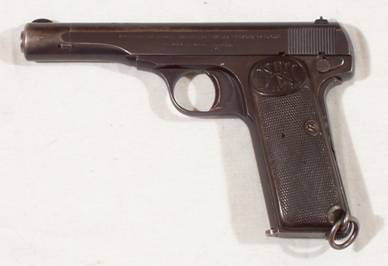
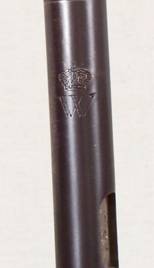
The Netherlands
adopted the M1922 FN Browning in .380 acp in the early 1920s. It
was designated the Pistol M25 No. 2. The top of the slide was stamped
with the Dutch crest.
Norway.

Photo courtesy www.collectiblefirearms.com.
Norway purchased
300 Colt M1911 .45 acp pistols and adopted them as the M1912. They
then purchased the rights to produce the Colt M1911. 500 pistols
were produced by the Kongsberg Arsenal in the M1912 configuration, which
was identical to the Colt M1911. By 1914 the slide stop had been
changed to extend down & further back, making it easier to reach with
the thumb. This redesigned pistol was adopted as the M1914.
Approximately 33,000 M1914 pistols were produced.
Poland.
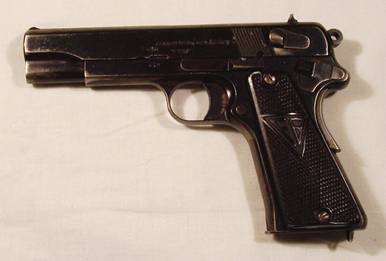
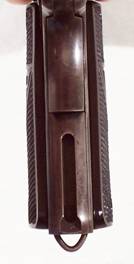
Poland adopted a
modified Colt Browning pistol in 1935 as the VIS Model 1935. The
main change from the basic Browning design was the addition of a de-cocking
lever on the side of the slide. All of the Polish military pistols
have the Polish Eagle on the slide & are cut for a shoulder stock.
The illustrated pistol is of early German production that is cut for the
stock.
Portugal.
Portugal bought
& issued 9X19 Luger pistols from Germany as the M/908 & M/43 Parabellum.
In addition, she bought Savage .32 acp M1907 pistols from the US &
issued them as the M/908 & M/915. There was no domestic pistol
production for the military by Portugal.
Rumania.
Rumania purchased
Austrian Steyr M1912 pistols prior to WW1. Between WW1 & WW2
she purchased FN Browning M1935 Hi Powers and Italian Beretta M1934 pistols
for her military. After WW2 she issued Russian TT33 pistols.
There was no domestic production of pistols for the Rumanian military.
Russia.
Russia was late
in the adoption of a semi auto pistol. She had purchased large quantities
of the Mauser C96 broom handle pistol. In 1930 Russia adopted a Browning
type pistol, the TT (Tula Tokarev)33 in the C96 caliber of 7.63X25.
They designated their round as a 7.62X25, apparently to agree with their
7.62X54R rifle bore diameter.
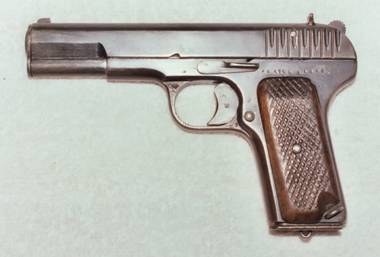
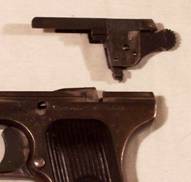
In 1933 the Russians
adopted a slightly modified pistol that was simpler to machine as the TT33.
The main feature of the TT30 & TT33 that make them an improvement over
the basic Browning design is that the hammer/sear mechanism can be removed
and replaced as a unit. With the slide removed they can be simply
lifted out of the frame.
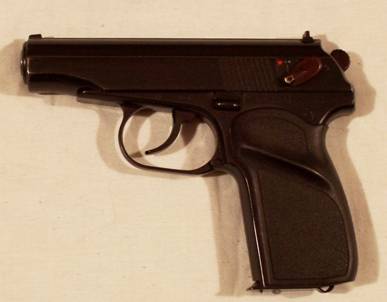
After WW2 Russia
adopted a Makarov designed pistol in 9X18 as the PM. It’s a double
action blow back operated pistol. The illustrated pistol is of East
German production.
Spain.
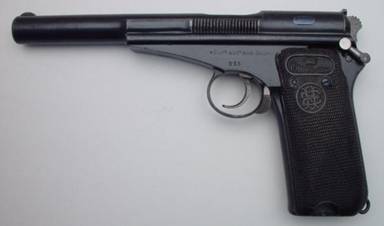
Photo courtesy www.collectorfirearms.us.
In 1913 Spain adopted
the Campo-Giro pistol in 9X23 Largo (long) caliber. In 1916 a modified
version was adopted as the M1913/16. This had the magazine release
relocated from behind the trigger guard to the bottom of the grip on the
left hand side.

In 1920 the Spanish
military decided that more modern pistols were available than the Campo-Giro.
New trials were held and the Astra 400 was the winner. This was an
unlocked blowback pistol in 9X23 Largo. It was adopted as the M1921.
By the later part
of WW2 the Spanish military had decided that they needed a more modern
pistol than the M1921. Field trials for a replacement started on
16 April, 1945. Star submitted examples of their Model A and prototypes
of the new Super A. The Model A was the winner but the Army was more
interested in the prototype Super A. The Navy agreed & the two
services decided to wait for the further development of the Super A.

Spanish Air Force
Star Model A.
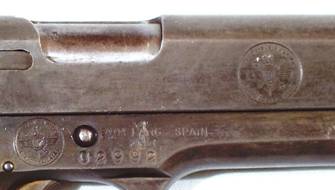
Spanish Air Force
markings on slide & receiver of Star Model A.
In 1945 the Star
Model A was adopted by the Spanish Air Force. It should be pointed
out that the Model A went through several modifications without Star changing
the Model number. The older Model As had a straight forward grip
frame. The illustrated pistol had the 1946 modification with the
finger rest added to the lower part of the frame.
In 1946 both the
Army and Navy adopted the Star Model Super A.
Sweden.
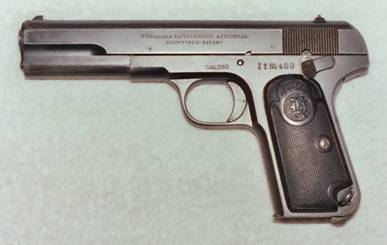
In 1907 the Swedish
military adopted the FN Browning M1903 pistol in 9 Browning Long as the
M1907. The first few pistols were FN made but most of the production
was done in Sweden.

In 1940 Sweden adopted
the Finnish Lahti in 9X19 as the Model 1940. The Swedish Lahti was
produced by Husqvarna.
Switzerland.
Switzerland was
one of the first countries to adopt an auto pistol in 1900. They
adopted the DWM produced Luger in .30 Luger caliber. In 1906 they
adopted an improved version of the Luger with a coil return spring instead
of the original flat one. During WW1 the supply of German produced
Luger pistols all went to the German military so Switzerland started producing
the Luger domestically. In 1929 it was re-designed to make manufacture
simpler & was re-designated the M1929.
The firm of SIG
in Neuhausen had been working on the development of a pistol using the
Petter improvements to the Browning design since the late 1930s.
By 1944 they had progressed to the Model 44/8, an 8 shot pistol.
This was improved further into the SP47/8. In 1949 it was adopted
by the Swiss as the M49.
Turkey.
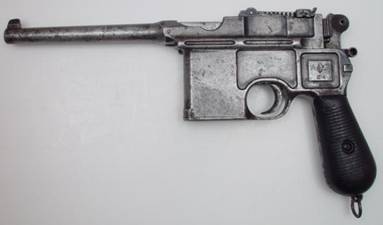
The first country
to adopt and issue an auto pistol was Turkey. They purchased 1092
7.63X23 Mauser M1896 pistols in 1896.
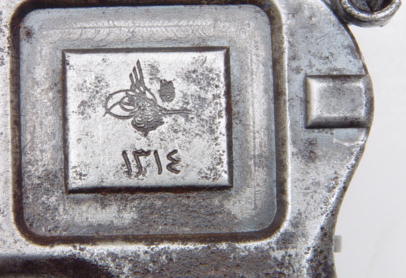
The rear sight markings
& markings on the left side of the pistol are in Farsi.
Turkey adopted the
FN Browning M1903 pistol prior to WW1. Around 8000 pistols were purchased.
This was the standard M1903 but was supplied with Turkish markings.
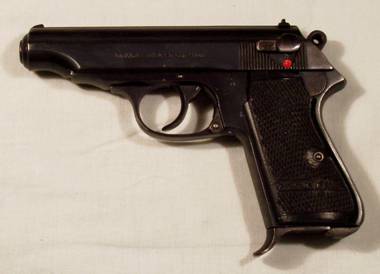
The first Turkish
produced military pistol was the Kirikkale in both .32 acp & .380 acp.
It was adopted after WW2 & is a direct copy of the Walther PP.
The illustrated pistol is marked on the left side in Turkish “For Officers
of the Turkish Army Only”.
United States.
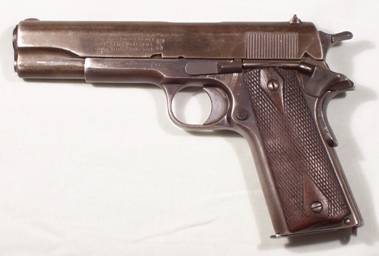
In 1900 the US army
started testing the Colt Browning locked breech pistols for possible military
acceptance. By 1911 they had evolved into the famous Colt .45 ACP.
It was adopted by the US military as the M1911.
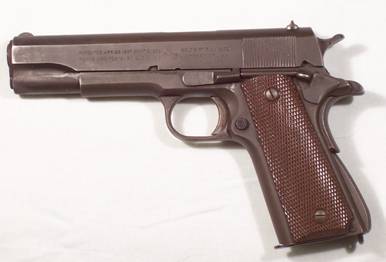
After WW1 improvements
were made in the pistol that included a longer tang on the grip safety
to prevent pinching of the web of the hand during recoil, adding an arched
magazine housing to make it fit the hand better, the trigger was made longer
& the serrations were eliminated, clearance cuts were made to the frame
on both sides behind the trigger to eliminate the sharp edges & the
width of the front sight was increased. With these changes the improved
pistol was adopted in 1926 & designated the M1911A1.
During WW2 the Colt
M1903 in .32 acp & M1908 in .380 were purchased by the army for issue
to General grade officers.
Yugoslavia.
When Yugoslavia
was founded after WW1 the primary military pistol was the Austrian Steyr
M1912.


During WW1 France
supplied both 7 & 9 shot Ruby pistol that they had purchased from Spain
to Serbia. Serbia was incorporated into Yugoslavia after WW1.
In 1933 Yugoslavia re-worked these Ruby pistols & designated them the
M33. These have the slide markings in Cyrillic.
Before WW2 they
adopted the FN Browning M1922 in .380 acp. In the late 1940s the
Russian Tokarev TT33 was adopted. A Yugoslavian copy of the TT33
but with a 9 round magazine was manufactured & adopted as the M57